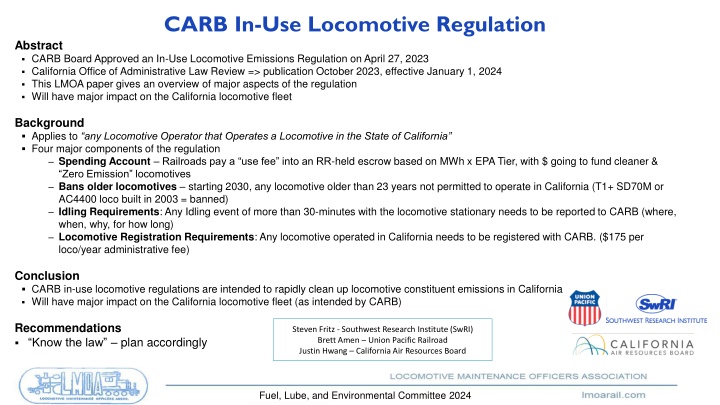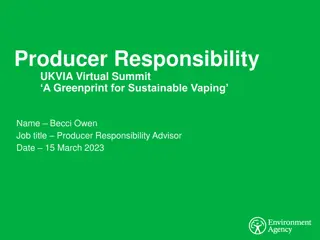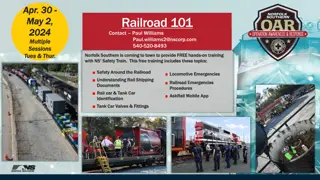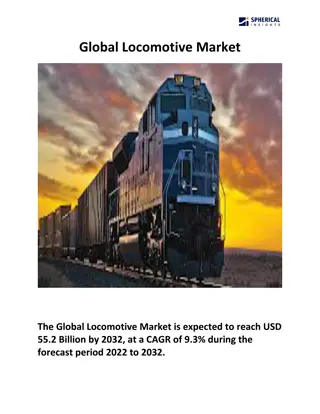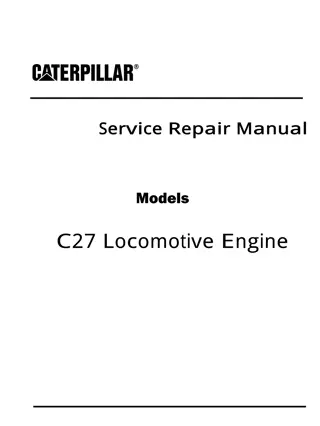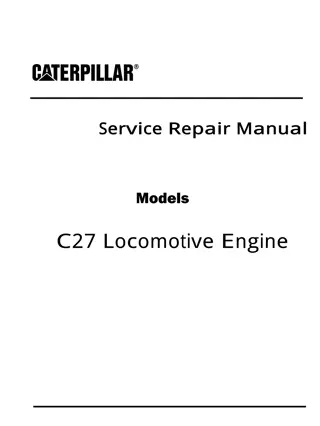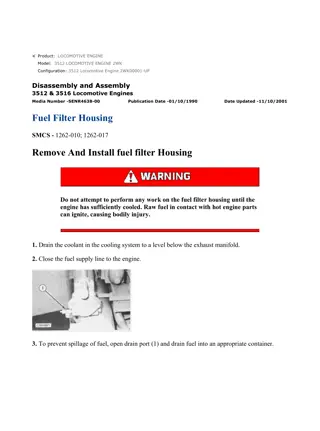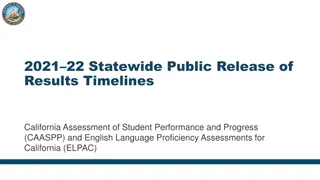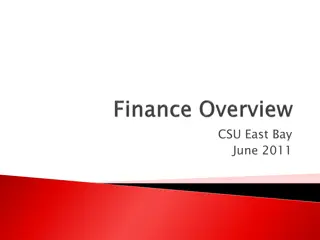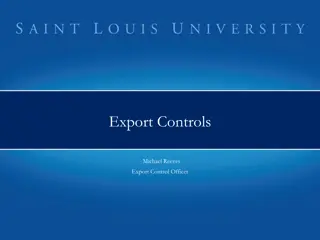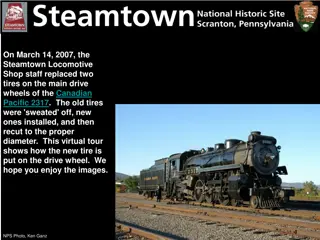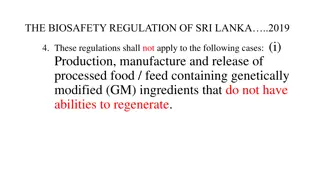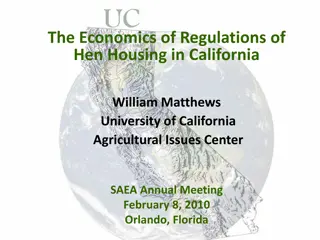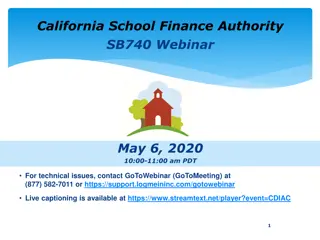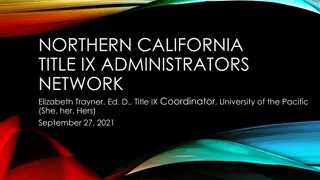California Locomotive Regulations Overview
Abstracts of CARB In-Use Locomotive Regulation and T4 Locomotive Incentive Grant Funding outlining major aspects and impacts on California's locomotive fleet. The regulations aim to clean up emissions, ban older locomotives, require registration, and incentivize T4 locomotive turnover. Grant programs facilitate legacy fleet turnover to T4. The papers provide recommendations for compliance and awareness of available grants.
Download Presentation

Please find below an Image/Link to download the presentation.
The content on the website is provided AS IS for your information and personal use only. It may not be sold, licensed, or shared on other websites without obtaining consent from the author.If you encounter any issues during the download, it is possible that the publisher has removed the file from their server.
You are allowed to download the files provided on this website for personal or commercial use, subject to the condition that they are used lawfully. All files are the property of their respective owners.
The content on the website is provided AS IS for your information and personal use only. It may not be sold, licensed, or shared on other websites without obtaining consent from the author.
E N D
Presentation Transcript
CARB In-Use Locomotive Regulation Abstract CARB Board Approved an In-Use Locomotive Emissions Regulation on April 27, 2023 California Office of Administrative Law Review => publication October 2023, effective January 1, 2024 This LMOA paper gives an overview of major aspects of the regulation Will have major impact on the California locomotive fleet Background Applies to any Locomotive Operator that Operates a Locomotive in the State of California Four major components of the regulation Spending Account Railroads pay a use fee into an RR-held escrow based on MWh x EPA Tier, with $ going to fund cleaner & Zero Emission locomotives Bans older locomotives starting 2030, any locomotive older than 23 years not permitted to operate in California (T1+ SD70M or AC4400 loco built in 2003 = banned) Idling Requirements: Any Idling event of more than 30-minutes with the locomotive stationary needs to be reported to CARB (where, when, why, for how long) Locomotive Registration Requirements: Any locomotive operated in California needs to be registered with CARB. ($175 per loco/year administrative fee) Conclusion CARB in-use locomotive regulations are intended to rapidly clean up locomotive constituent emissions in California Will have major impact on the California locomotive fleet (as intended by CARB) Recommendations Know the law plan accordingly Steven Fritz - Southwest Research Institute (SwRI) Brett Amen Union Pacific Railroad Justin Hwang California Air Resources Board Fuel, Lube, and Environmental Committee 2024
T4 Locomotive Incentive Grant Funding Abstract Several incentive grant funding programs available to facilitate turnover of legacy locomotive fleet to T4 CARB In-Use Locomotive Regulation should accelerate T4 locomotive options This LMOA paper reviews a sample of incentive grant funding programs available mid-2024 Emphasizes what strings are attached to grant funds Background EPA and CARB awareness of lower-than-expected locomotive turnover rate to cleaner locomotives CARB In-Use Locomotive Regulation designed to significantly accelerate legacy locomotive turnover & cleanup Locomotive replacement to T4 is recognized as an attractive and cost-effective source of NOx reduction Several Federal, State, and NOx Mitigation grant programs to incentivize locomotive replacement with T4 Grants come with a significant amount of bureaucracy, administrative work, and reporting, and can extend project timelines Conclusion CARB in-use locomotive regulations are intended to rapidly clean up locomotive constituent emissions in California and incentive grants will play a part Awareness of grant availability, timelines for applications, time to award, and long-term reporting requirements need to be considered Recommendations OEM s and Railroads should maintain awareness of these incentive grant opportunities Make sure your organization fully understands what strings are attached to incentive grants Steven Fritz - Southwest Research Institute (SwRI), Tom Mack Z-ELTech, Jon Meinhardt Cummins, Michael Cleveland Peaker, Mark Duve - HPI Fuel, Lube, and Environmental Committee 2024
Biofuels and Low Temperature Properties LMOA Fuels, Lubes and Environmental Committee 2024 Abstract The production and chemistry of biofuels such as biodiesel and renewable diesel are described. The cold flow properties used to determine low temperature operability are defined. The typical low temperature properties of biodiesel and renewable diesel are reported with emphasis on how they relate to the feedstock, compare to petroleum diesel, and meaning in real world applications. Various strategies to use biofuels in low temperature climates are explained. Background The use of biofuels such as biodiesel and renewable diesel is growing as railroads change their fuel composition to meet carbon reduction targets. While renewable diesel has been described as a drop-in replacement for petroleum diesel, both renewable diesel and biodiesel can have operational issues (e.g. filter plugging) at low temperatures. There is a desire to understand how to use biofuels in low temperature environments without issues. Conclusion Biofuels can be successfully used in low temperature climates provided that the cold flow properties are appropriate for all locations in which the fuel will be consumed. Blending biodiesel or renewable diesel with petroleum-based diesel can help to ensure low temperature operability. For certain fuel combinations, cold flow improvers and pour point depressants can extend the temperatures at which a fuel can be used. Recommendation The low temperature properties of biofuels should be verified prior to use in low temperature environments. Suzanne Golisz Innospec Stephanie Jaworski Imperial Oil Terry Degerness CPKC Vu Tran - Infineum
Biodiesel Handling & Blending Abstract Primary objective of this paper is to provide a high-level guidance document that enables incorporation of higher biodiesel blends in the railroad fueling networks Biodiesel, Petroleum Diesel, fuel equipment, Operating Conditions, Procedures, Quality Control Fuel Equipment, Operating conditions, Procedures - Provide clarity on limitations where applicable of handling / blending of biodiesel based on fueling locations & other key parameters Quality Control - Provides insight into key fuel quality parameters that provide critical input into procurement planning and troubleshooting of biodiesel handling Biodiesel & Diesel - Recommendations on blending variations i.e., blend on site or pre blended fuel procurement and associated trade-offs Background Railroads are currently using more biofuels than ever driven by SBTi based GHG reduction targets & related reporting needs, set up by railroads Policy landscape is also driving adoption of biodiesel either via incentives or other such requirements OEMs are in process of approving biodiesel blends upto B20 further bolstering the need for clarity on this subject. There has been increased use at more locations with higher percentages of biofuel in the blend. Some locations are using pre blended fuel directly from their supplier. Other locations are choosing to blend biodiesel with diesel at their facility. While the overall experience with handling biofuels has been positive, there have been opportunities for improvements that arise that provide shared lessons learned and provide guidance /recommendations. Conclusion For fueling locations characterized by certain environmental conditions for various desired blend levels, the decision makers should consider the option that provides the best outcomes in terms of solution confidence, economics and quality traceability Best practices guidance document for handling of biodiesel and blends will be delivered as part of this paper Flow Chart with possible outcomes will also be included for step-by-step decision making Rajani Modiyani Chevron REG Jeremy Barnes Norfolk Southern Glen Smith Argus Consulting Dwight Beebe Temple Engineering Randy Garver Innospec Fuel, Lube, and Environmental Committee 2024
Railroad GHG Emissions Accounting with Biofuels LMOA Fuels, Lubes and Environmental Committee 2024 Abstract North American Class I railroads collectively consume 3.5 billion gallons of diesel fuel each year All Class I railroads have partnered with SBTi (Science Based Targets) to aggressively reduce GHG emissions by 2030 The uptake in the use of biofuels has been increasing in recent years to help meet SBTi goals How are North American Class I railroads treating biofuels from a GHG accounting standpoint? What precedence, if any, have other railroads outside North America set for how to address the increased use of biofuels Canadian railroads will require a more precise fuel management and measurement system to address legislative requirements How can the industry standardize around a common GHG accounting methodology related to biofuels Background Each Class I railroad chooses their own voluntary goals and which scope emissions will be included Some railroads have set aggressive biofuel uptake goals by 2030 to help meet their SBTi emissions reduction goals Is there a consensus on the accounting for the carbon intensity of biofuels, is it batch specific? What new measurement systems will be required to account for either state or provincial boundary biofuel purchase and/or consumption Conclusion Biofuels present a relatively clear path to significantly reduce GHG emissions by the near term 2030 SBTi goals A common accounting methodology will build industry confidence in adopting biofuels as a strategic plank towards emissions reduction New measurement systems may be required to meet legislative reporting metrics by state and/or province Recommendation Best practice sharing in terms of biofuels accounting methodology Industry collaboration and technology sharing for augmented fuel measurement systems A standardized approach to SBTi reporting amongst all the Class I railroads for locomotive fuel consumption with biofuel blends Wayne A. Kennedy Railroad Consultant Steve Fritz Southwest Research Institute Veronica Bradley Clean Fuels Alliance America Sarah Elsokkary Arcadis Rajani Modiyani Chevron REG
